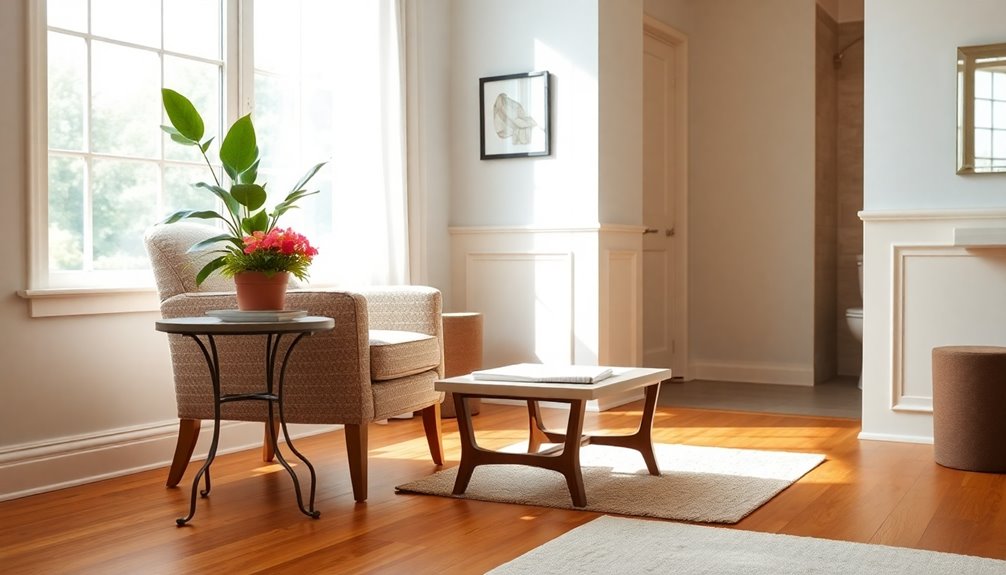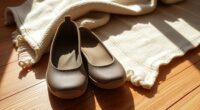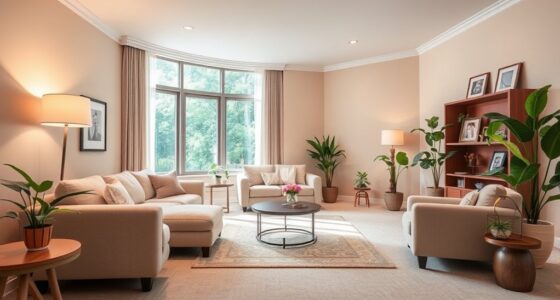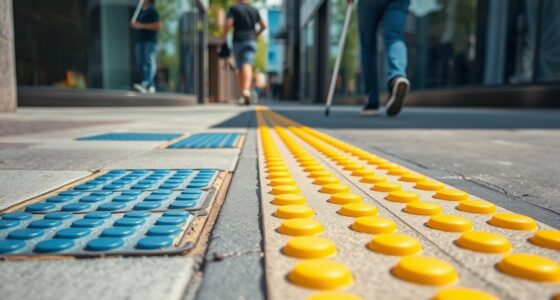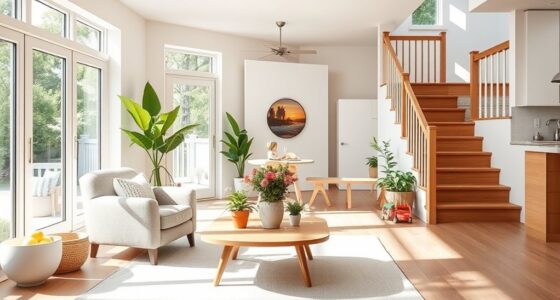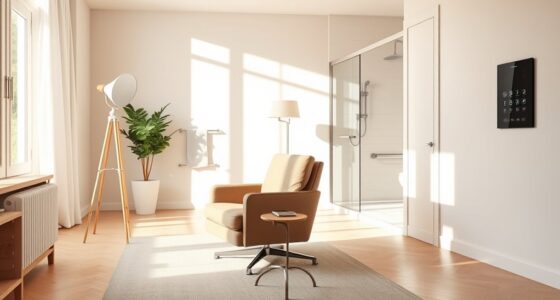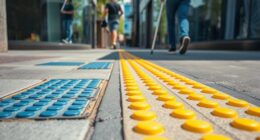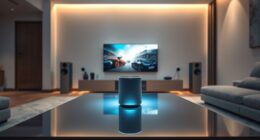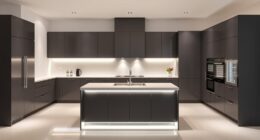To create a safe and comfortable home for seniors, prioritize open floor plans to minimize trip hazards, incorporate ample natural light for better visibility, and choose ergonomic furniture for healthy posture. Use user-friendly storage solutions at waist level and opt for non-slip flooring throughout the home. Don't forget bathroom modifications like grab bars and a safe kitchen design. With these age-friendly secrets, you can guarantee independence and safety at home. Keep exploring to discover even more ideas!
Key Takeaways
- Open floor plans enhance visibility and safety, minimizing trip hazards and facilitating navigation for mobility aids.
- Ample natural light and bright, glare-free illumination improve visibility and reduce fall risks in the home.
- Non-slip flooring choices, like low-pile carpeting and anti-slip coatings, help prevent accidents and ensure safe movement.
- Ergonomic furniture with lumbar support and user-friendly storage solutions foster comfort and independence for seniors.
- Bathroom modifications, including grab bars and walk-in showers, enhance safety and accessibility in essential spaces.
Open Floor Plans to Minimize Trip Hazards
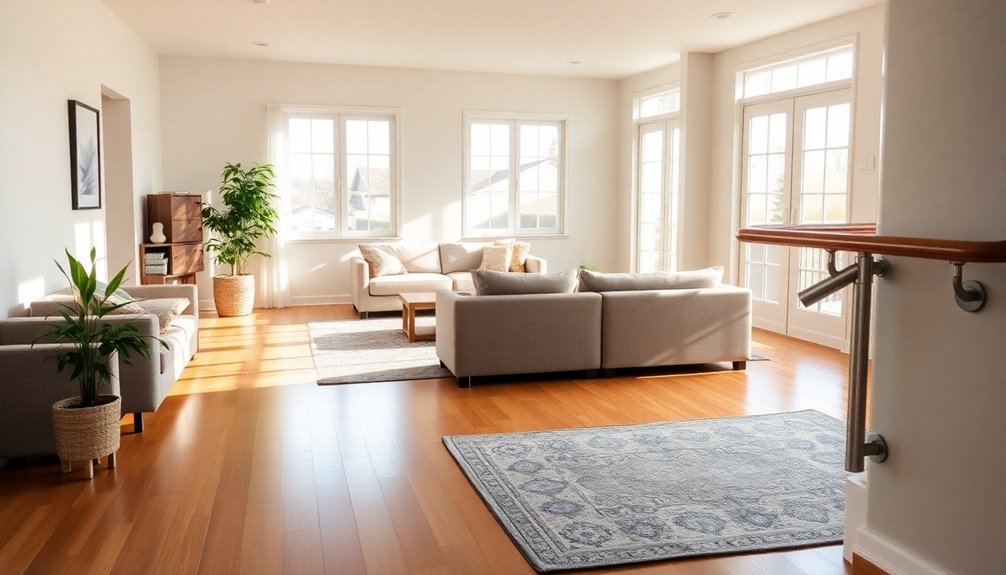
When designing a senior home, prioritizing safety is essential, and open floor plans can play a significant role in reducing trip hazards.
These designs eliminate unnecessary walls and barriers, creating spacious living areas that enhance visibility and awareness of surroundings. The continuous flow between spaces, like the kitchen and living room, facilitates easier navigation with mobility aids such as walkers and wheelchairs.
By minimizing doorways and thresholds, you reduce the risk of falls. Incorporating slip-resistant flooring in high-traffic areas further improves safety, while ample natural lighting helps seniors with visual impairments move confidently within their homes. Additionally, using HEPA filtration in air purifiers can significantly improve indoor air quality, contributing to a healthier living environment for seniors.
With open floor plans, you're not just enhancing comfort; you're actively contributing to a safer living environment for seniors.
Ample Natural Light for Enhanced Visibility
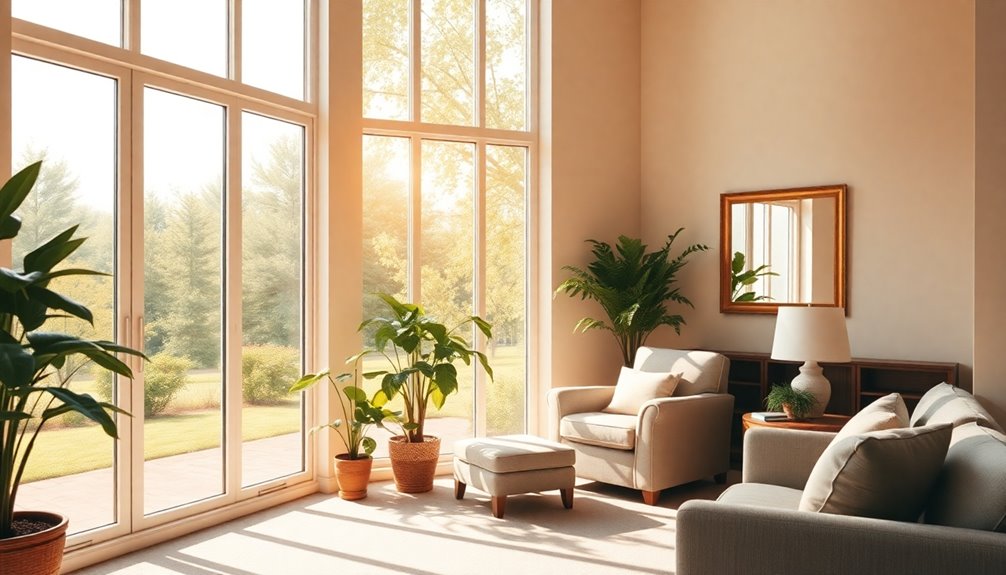
Creating a home filled with ample natural light not only makes spaces feel more inviting but also plays an essential role in enhancing visibility for seniors.
Well-lit environments help reduce the risk of falls by improving contrast, which is significant as vision often declines with age. Incorporating large windows and skylights allows natural light to flood in, creating a brighter atmosphere that can enhance mood and cognitive function.
Using light-colored walls further maximizes this effect. Positioning mirrors strategically can reflect and amplify the natural light, boosting visibility without relying solely on artificial lighting.
Additionally, sheer window treatments let in natural light while ensuring privacy, making seniors feel comfortable and secure in their living spaces. Furthermore, proper insulation and sealing can help maintain a consistent indoor temperature, creating a more pleasant environment for seniors.
Ergonomic Furniture for Healthy Posture
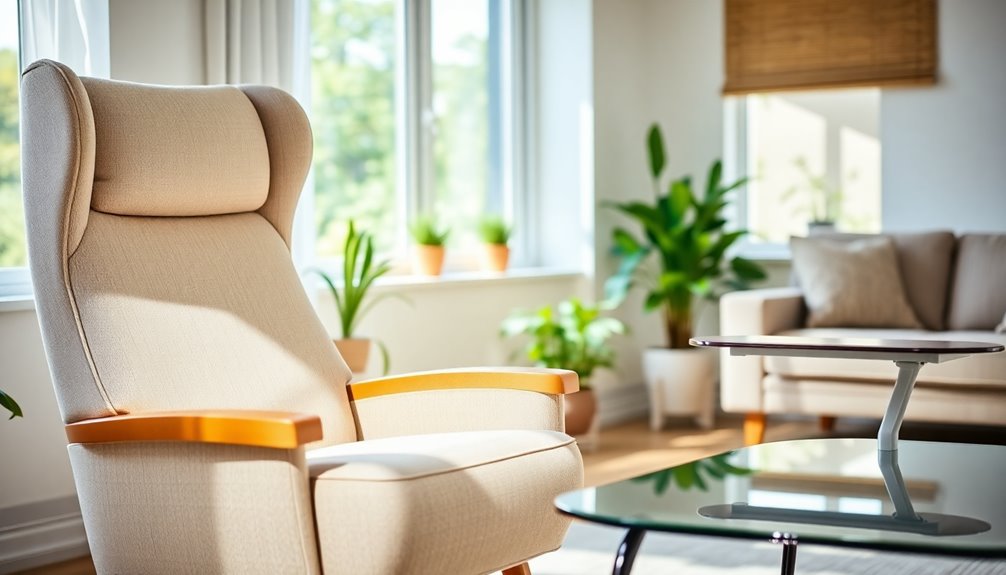
To maintain a healthy posture while maneuvering daily activities, choosing ergonomic furniture is essential for seniors. Features like lumbar support and height-adjustable desks allow you to customize your position, reducing strain on shoulders and neck strain. This not only alleviates discomfort but also promotes a neutral spine position, critical for long-term health. Regular inspections and proper venting of your living environment can also contribute to overall well-being by ensuring a safe and comfortable atmosphere.
| Furniture Type | Benefits |
|---|---|
| Lumbar Support Chairs | Reduces back pain and discomfort |
| Height-Adjustable Desks | Promotes better alignment and flexibility |
| Ergonomic Accessories | Minimizes neck strain and enhances productivity for older adults |
Investing in ergonomic furniture is an essential aspect of home office design, ensuring comfort and increasing productivity for older adults while maintaining a healthy posture.
User-Friendly Storage Solutions for Easy Organization
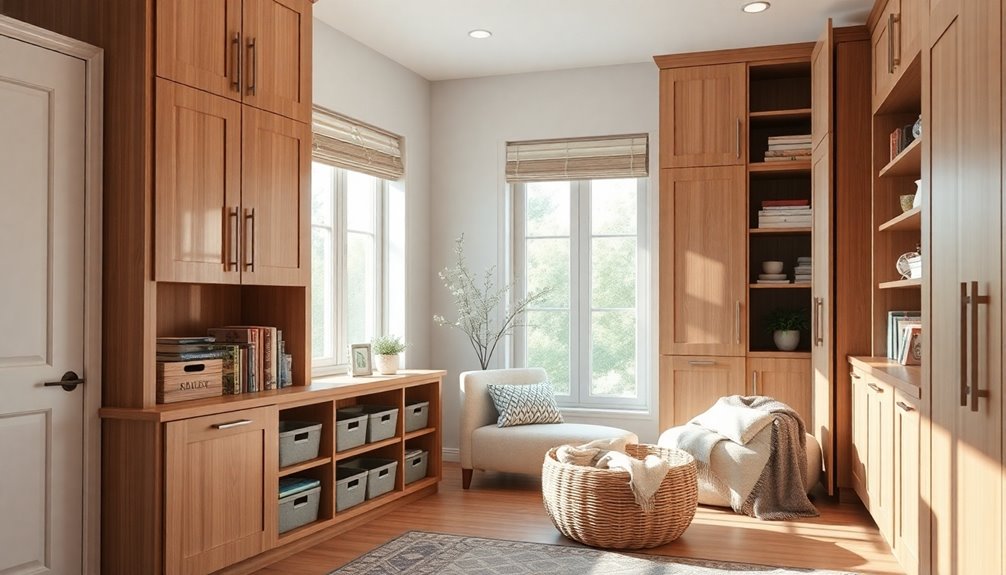
Choosing ergonomic furniture can greatly improve comfort, but an equally important aspect of a senior-friendly home is effective storage. Opt for user-friendly storage solutions that enhance usability and promote accessible home design.
Incorporating soft-close drawers and D-shaped cabinet handles makes opening and closing storage effortless, reducing the risk of finger pinching. Positioning frequently used items at waist level minimizes the need for reaching or climbing, promoting safety and efficiency.
Implement clear labeling on storage containers and shelves to aid quick identification and retrieval, fostering independence. Finally, guarantee adequate lighting, like LED strip lights in closets, to improve visibility and reduce the risk of accidents when searching for items.
These thoughtful adjustments create an organized and efficient living space for seniors.
Safe Flooring Choices to Reduce Fall Risks
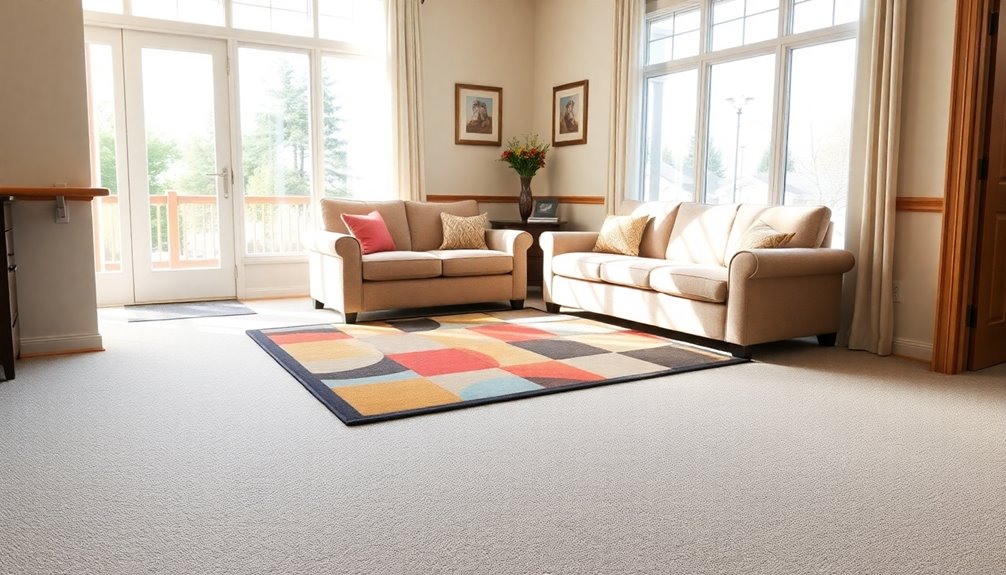
When choosing flooring for senior homes, focus on non-slip surfaces to greatly reduce fall risks.
Eliminate tripping hazards by selecting options like low-pile carpeting or secured area rugs.
Regular maintenance is key to keeping these surfaces safe and clean, so don't overlook that essential step. Additionally, consider incorporating best vacuums for dust removal which can help maintain a clean environment and further reduce the risk of slips and falls.
Non-Slip Surface Options
As you consider flooring options for senior homes, non-slip surfaces play an essential role in enhancing safety and reducing fall risks. Non-slip flooring materials like textured vinyl, rubber, and cork provide enhanced grip, making them ideal choices.
You can also apply anti-slip coatings on existing surfaces, especially in moisture-prone areas such as bathrooms and kitchens, to improve traction. Low-pile carpets are another excellent option, offering stability and comfort while minimizing trip hazards.
Additionally, using area rugs with secured edges can add cushioning and safety without compromising aesthetics. Incorporating efficient energy use in design can further promote a safer and more comfortable environment for seniors.
Eliminate Tripping Hazards
To create a safer environment in senior homes, it's crucial to eliminate tripping hazards through careful flooring choices.
Here are some tips to help you optimize safety:
- Opt for low-pile, wall-to-wall carpeting for stability and comfort.
- Avoid small, lightweight throw rugs; use large area rugs with secured edges.
- Choose non-slip vinyl or laminate flooring to enhance traction.
- Eliminate thresholds between rooms to minimize trip risks.
- Regularly assess flooring surfaces to verify they're in good condition.
- Consider integrating air quality improvements through air purifiers to further enhance the overall safety and health of the living environment.
Regular Maintenance Importance
Maintaining safe flooring in senior homes goes hand in hand with choosing the right materials. Regular maintenance is essential for ensuring slip-resistant surfaces, greatly reducing fall risks for seniors.
Opt for low-pile, wall-to-wall carpeting for safety, and steer clear of small, lightweight throw rugs that could slide and cause falls. In wet areas, anti-skid bathroom tiles are vital; make sure proper drainage is in place to prevent water accumulation.
Keeping floors clutter-free and routinely checking for damages helps eliminate tripping hazards. Additionally, utilizing large area rugs with secured edges can enhance stability while providing comfort and reducing noise.
Prioritizing these flooring choices creates a safer environment for seniors, allowing them to move around confidently.
Accessible Entryways for Easy Navigation
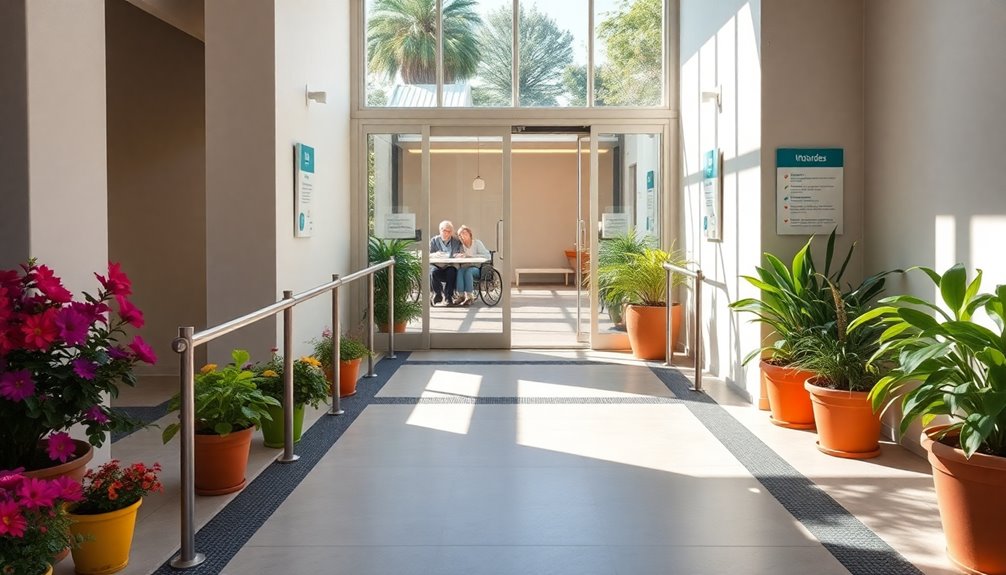
When designing accessible entryways, you want to prioritize no-step entries to eliminate barriers for everyone, especially those with mobility aids.
Proper lighting is essential, as it enhances visibility and helps prevent accidents during nighttime access.
Clear pathways free of obstacles will guarantee smooth navigation, making every entry and exit safe and easy.
No-Step Entries
Creating a home that's truly accessible means incorporating no-step entries, which eliminate physical barriers and allow seniors to navigate their space with ease.
These features are essential for anyone facing mobility limitations. Here are some key elements to take into account:
- Gentle slopes or ramps with a maximum incline of 1:12
- Wide doorways (at least 36 inches) for smooth navigation
- Handrails for added support and stability
- Adequate lighting for visibility during low-light conditions
- Thoughtful design to enhance safety and ease of use
Proper Lighting Installation
Proper lighting installation transforms entryways into safe, welcoming spaces for seniors.
To enhance visibility, you'll want to use bright, glare-free illumination that prevents accidents, especially for those with declining vision.
Installing motion-sensor lights at entry points guarantees the lights activate automatically, providing both convenience and safety.
Utilizing two-way switches lets you control the lighting from both inside and outside, reducing fall risks when shifting between spaces.
Combine ambient lighting with task lighting, like wall sconces or recessed lights, to illuminate areas where seniors may fumble with keys or packages.
Finally, make certain that all fixtures are positioned at appropriate heights and are easily accessible, supporting independent navigation and enhancing overall safety in your entryways. Additionally, consider integrating smart home devices that can further enhance security and convenience for seniors.
Clear Pathway Design
To guarantee seniors navigate their homes easily, clear pathway design is essential. By focusing on these features, you can enhance safety and accessibility:
- Maintain pathways with a minimum width of 36 inches for easy movement.
- Ascertain entryways provide no-step access to eliminate barriers.
- Use proper lighting, like motion-sensor lights, for visibility.
- Incorporate non-slip surfaces in outdoor areas to prevent accidents.
- Optimize furniture layout for a clutter-free environment.
These elements create clear pathways, accommodating seniors with mobility limitations. Additionally, incorporating energy-efficient models can also contribute to a safer environment by reducing the risk of accidents related to poor lighting.
Proper Lighting in High-Traffic Areas
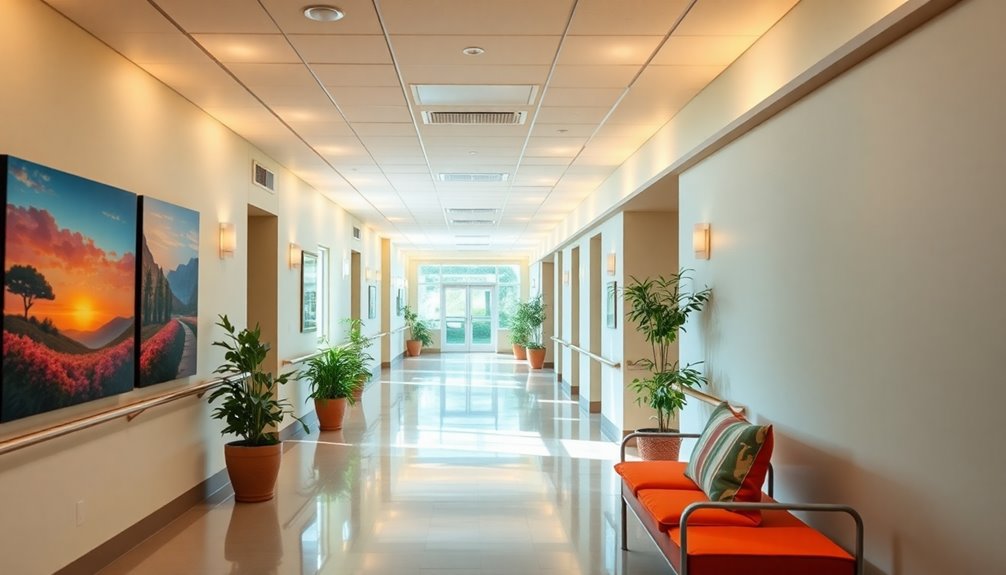
When you guarantee high-traffic areas are well-lit, you greatly lower the risk of falls, which can be essential for seniors. Proper lighting considerably reduces accidents, making spaces like entryways and hallways safer.
Installing motion-sensor lights enhances visibility, automatically activating as someone approaches. Opting for LED bulbs not only provides brighter illumination but also saves energy and lasts longer than traditional options.
Incorporating task lighting in kitchens and other areas improves visibility for specific tasks, reducing strain on aging eyes. Additionally, confirm that light switches are at convenient heights and easy to operate, like rocker switches, to promote independence. Moreover, ensuring good air quality through HEPA filters can further enhance the living environment for seniors by reducing allergens and improving respiratory health.
With these adjustments, you can create a safer, more accessible environment for seniors.
Bathroom Modifications for Increased Safety
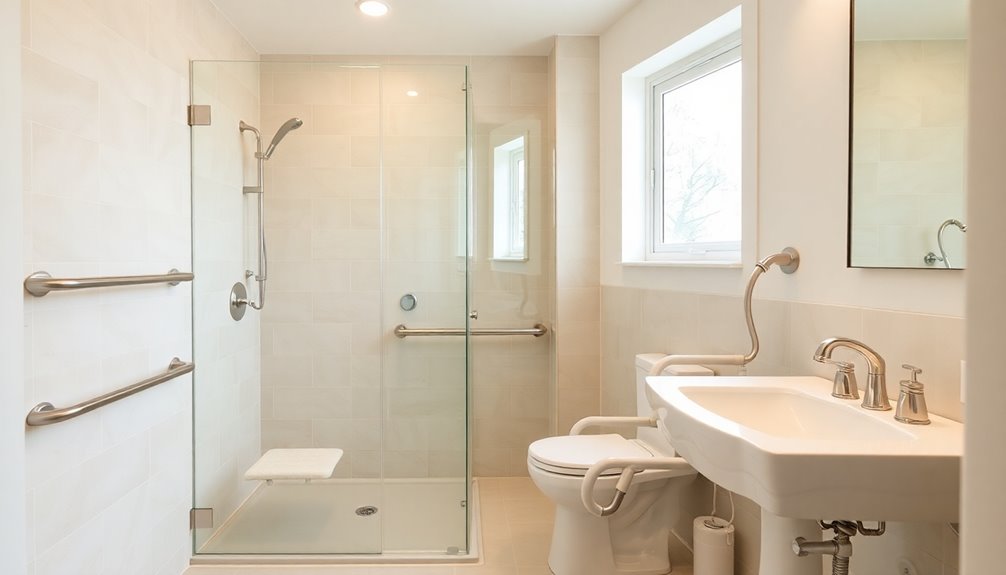
To enhance safety in the bathroom, consider installing grab bars in key areas like next to the toilet and inside the shower.
Walk-in showers with non-slip surfaces and built-in seating can also make a big difference for those with mobility challenges.
These modifications not only reduce the risk of falls but also promote independence and comfort. Additionally, incorporating assistive listening devices can help seniors who may struggle to hear important sounds, such as alarms or calls for help.
Grab Bars Installation
Installing grab bars in your bathroom is crucial for enhancing safety and preventing falls, especially for seniors.
These bars provide essential support to guarantee bathroom safety and accessibility. Here are some key points to take into account during installation:
- Install grab bars near the toilet and within the shower or bathtub.
- Select grab bars capable of supporting at least 250 pounds for maximum weight support.
- Position them 33 to 36 inches above the floor for ideal accessibility.
- Securely anchor grab bars into wall studs or use toggle bolts for drywall.
- Choose bars with a non-slip surface to enhance grip in wet environments.
Walk-In Shower Benefits
Walk-in showers offer numerous benefits that can greatly enhance safety and comfort for seniors. By eliminating the need to step over high tub walls, they greatly reduce the risk of falls, promoting safer bathing experiences.
Walk-in showers can be designed with slip-resistant flooring and grab bars, ensuring maximum safety and accessibility. For those with limited mobility, a handheld showerhead provides flexibility, making it easier to bathe independently.
Built-in seating offers comfort and stability, allowing you to rest while showering. The open design accommodates assistive devices like shower chairs or walkers, further supporting your independence in the bathroom.
Senior-Friendly Kitchen Design for Usability
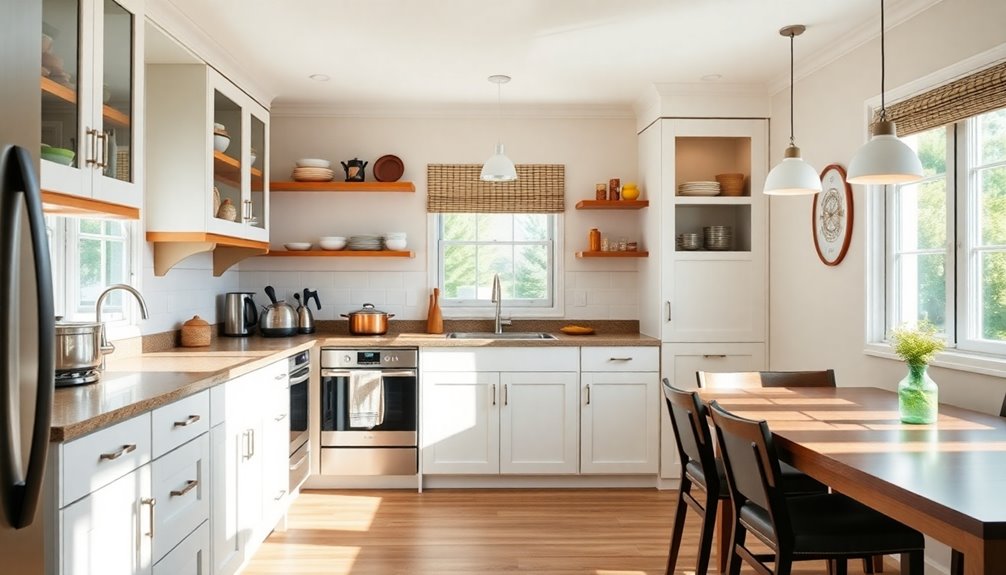
Creating a senior-friendly kitchen is all about enhancing usability and safety.
You'll want to focus on features that simplify tasks and reduce hazards. Consider these essential elements:
- Pull-out shelves and drawers for easy access
- Lever-style faucets for effortless operation
- Adequate lighting to improve visibility
- An open layout to facilitate movement
- Non-slip flooring to prevent falls
Incorporating these elements into your kitchen design not only helps older adults navigate their space more comfortably, but it also encourages independence.
An open layout with pathways at least 36 inches wide allows for smooth movement, while pull-out shelves eliminate the need for bending.
With adequate lighting and lever-style faucets, cooking becomes a safer and more enjoyable experience.
Technology Integration for Enhanced Independence
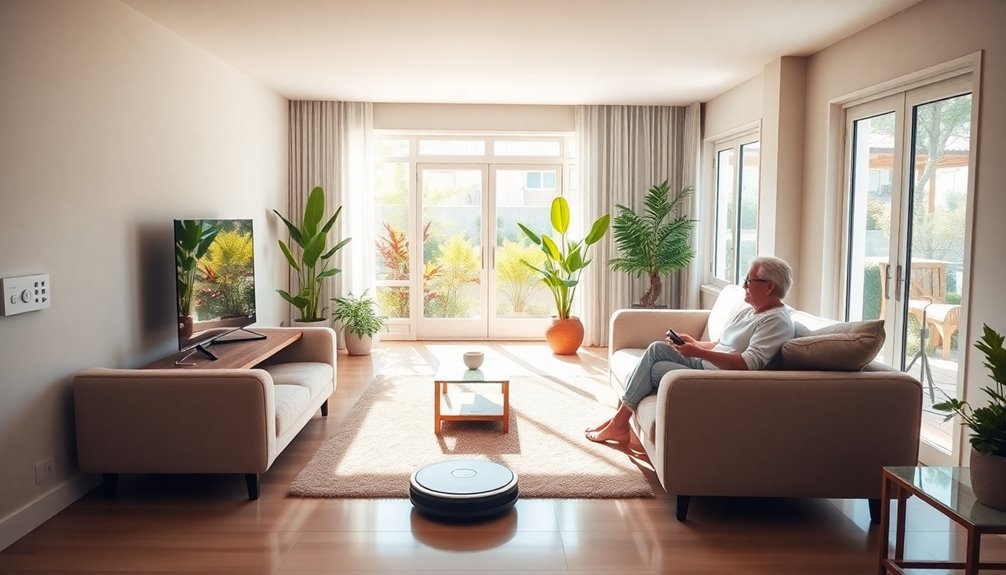
As technology continues to evolve, integrating smart solutions into senior homes can greatly boost independence and safety.
Smart home technology, like voice-activated assistants, allows you to control lighting, temperature, and security systems effortlessly. Automated medication dispensers guarantee you take the right dosage at the right time, minimizing medication errors.
Home security systems equipped with motion sensors and smart cameras provide real-time alerts about unusual activity, enhancing your peace of mind. Smart lighting solutions, such as motion-sensor lights, illuminate pathways automatically, reducing fall risks.
Additionally, wearable technology, including medical alert devices, empowers you to monitor your health and summon help in emergencies.
Frequently Asked Questions
How to Make a Home More Senior Friendly?
To make your home more senior-friendly, start by installing grab bars in bathrooms and along stairways for essential support.
Replace doorknobs with lever-style handles to ease operation for those with limited hand strength.
Confirm your living spaces are well-lit with bright, glare-free lighting, and consider widening doorways to accommodate mobility aids.
Finally, choose non-slip flooring materials in areas prone to moisture, like kitchens and bathrooms, to reduce the risk of falls.
What Is the Most Desirable Home Design for Aging in Place?
Imagine walking into a home where every detail caters to your comfort.
The most desirable design for aging in place includes features like no-step entries and wider doorways, making navigation effortless.
Picture an open floor plan that allows for easy movement, with grab bars in the bathroom for safety.
Adjustable countertops and non-slip flooring adapt to your changing needs, ensuring you feel secure and independent in your living space.
How to Design a House for Seniors?
To design a house for seniors, start by incorporating wider doorways and hallways to guarantee easy mobility.
Choose a single-level floor plan to eliminate stairs, which can be hazardous.
Use non-slip flooring and install grab bars in bathrooms for safety.
Opt for walk-in showers and comfort-height toilets to enhance accessibility.
Finally, enhance lighting with bright fixtures and motion sensors to improve visibility, especially during nighttime, reducing the risk of accidents.
How to Design for Elderly People?
When you design for elderly people, focus on enhancing safety and accessibility.
Consider wide doorways and hallways to accommodate walkers or wheelchairs. In bathrooms, install features like grab bars and walk-in showers to prevent falls.
Use lever-style handles for doors and faucets to make everyday tasks easier. Guarantee ample lighting in all areas to improve visibility and create single-level living spaces to eliminate stair hazards, promoting independence and comfort.
Conclusion
Designing a senior home with these age-friendly secrets is like crafting a safety net that supports independence and comfort. By incorporating open spaces, plenty of natural light, and ergonomic furniture, you create an environment that embraces the needs of older adults. Thoughtful modifications in kitchens and bathrooms further enhance usability and safety. With these elements in place, you’re not just building a home; you’re fostering a sanctuary that empowers seniors to thrive in their golden years. Additionally, integrating smart technology can further enhance the living experience, offering seniors the ability to monitor their health and stay connected with loved ones effortlessly. Implementing universal design tips for seniors, such as lever-style door handles and non-slip flooring, ensures that the home remains accessible and safe. By prioritizing these features, you can create a harmonious space that not only meets practical needs but also enriches the quality of life for older adults.
